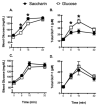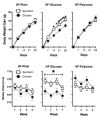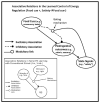A view of obesity as a learning and memory disorder
- PMID: 25453037
- PMCID: PMC4247176
- DOI: 10.1037/xan0000029
A view of obesity as a learning and memory disorder
Abstract
This articles describes how a cascade of associative relationships involving the sensory properties of foods, the nutritional consequences of their consumption, and perceived internal states may play an important role in the learned control of energy intake and body weight regulation. In addition, we describe ways in which dietary factors in the current environment can promote excess energy intake and body weight gain by degrading these relationships or by interfering with the neural substrates that underlie the ability of animals to use them to predict the nutritive or energetic consequences of intake. We propose that an expanded appreciation of the diversity of orosensory, gastrointestinal, and energy state signals about which animals learn, combined with a greater understanding of predictive relationships in which these cues are embedded, will help generate new information and novel approaches to addressing the current global problems of obesity and metabolic disease.
Figures













References
-
- Bartoli F, Carra G, Crocamo C, Carretta D, Clerici M. Metabolic Syndrome in People Suffering from Posttraumatic Stress Disorder: A Systematic Review and Meta-Analysis. Metabolic Syndrome and Related Disorders. 2013;11(5):301–308. - PubMed
-
- Begg DP, Woods SC. The endocrinology of food intake. Nature Reviews Endocrinology. 2013;9(10):584–597. - PubMed
Publication types
MeSH terms
Grants and funding
LinkOut - more resources
Full Text Sources
Other Literature Sources
Medical

